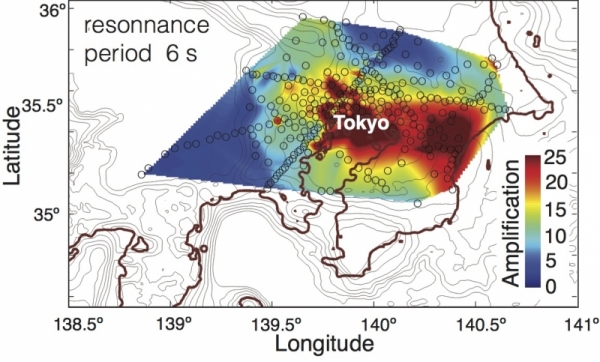
Figure: From Denolle et al (2014b), seismic amplification due to isotropic incident seismic waves in Kanto sedimentary basin. Contour lines are 500 m isosurface Vs = 3.2 km/s (Koketsu et al, 2009)
When seismic waves travel through soft sediments, and particularly in basins, they get trapped, their amplitude amplify and the duration of strong shaking increases. In Japan, I use the Metropolitan Seismic Observatory network (MeSO-net) to investigate natural resonance under Tokyo. The Kanto basin is 4km deep, with poorly consolidated sediments (Vs~ 500 m/s) surrounded by stiff bedrock.
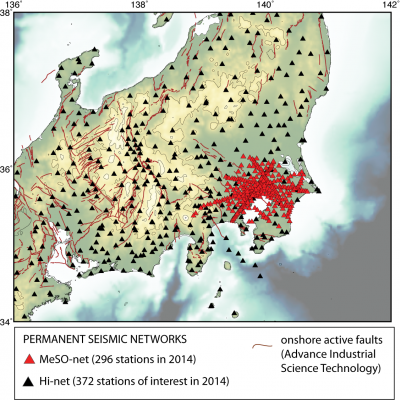 |
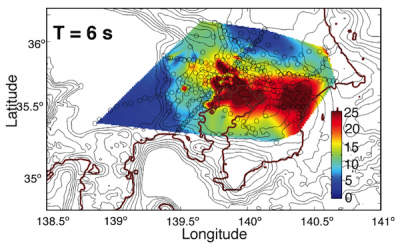 |
|---|---|
| Figure 2 (left): I use about 370 stations from Hi-net network (black triangles) and 296 station from the MeSO-net (red triangles). | Figure3 (right): Seismic amplification recorded in MeSO-net receivers filtered around 6 seconds. The contour lines are the basement of the sedimentary basin and show correlation between amplification and basin depth (from Denolle et al., 2014b). |
When seismic waves hit interfaces with strong impedance, such as basin wall, they reflect, refract and convert to other phase. With dense seismic networks, we can retrieve such effect using the ambient seismic field. We calculate the vertial-to-vertical corelation, expecting the fundamental mode of surface waves to dominate.
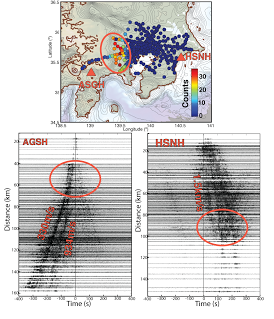 |
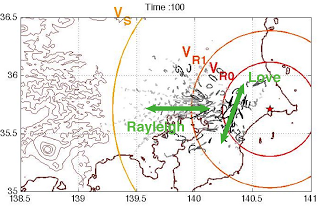 |
|---|---|
| Figure 4 (left): Reflection and phase conversion at the western basin edge viewed from the vertical-to-vertical correlations from two virtual sources AGSH and HSNH (hinet stations). | Figure 5 (right): Snapshot a 100s of polarization of the ZN-ZE components of the correlation from MeSO-net station DICM. The fast arrival resembles a Rayleigh waves, the and second arrival resembles a Love wave. This conversion from Rayleigh-to-Love may be due to then shallow dipping eastern basin edge. |
We can use the Green’s functions from the ambient seismic field to directly predict ground motion. The 9 components of the ambient seismic field Green’s tensor are the responses of the Earth to impulse forces located at the depth of the virtual source, i.e. at the surface. Realistic earthquakes are buried and have a dislocation mechanism that can be represented as a double couple. Once we know the surface-wave excitation at the virtual source location, we can correct the surface-wave impulse responses to predict ground motion.
IMAGE_NOT_FOUND
Validation of the virtual earthquakes against real earthquakes in southern California (Denolle et al., 2013).
We can also prescribe kinematically large sources that we discretize into point sources. For each point source, we correct for depth, mechanism, timing of event according to the slip history, and sum over all sources using the principle of superposition. We have focused our effort on predicting scenario earthquakes on the San Andrea Fault (Denolle et al 2014a) and on the Itoigawa-Shizuoka Tectonic Line (Denolle et al, 2017)
IMAGE_NOT_FOUND
Prediction of large virtual earthquake on the San Andreas Fault and LA basin amplification (Denolle et al., 2014a).
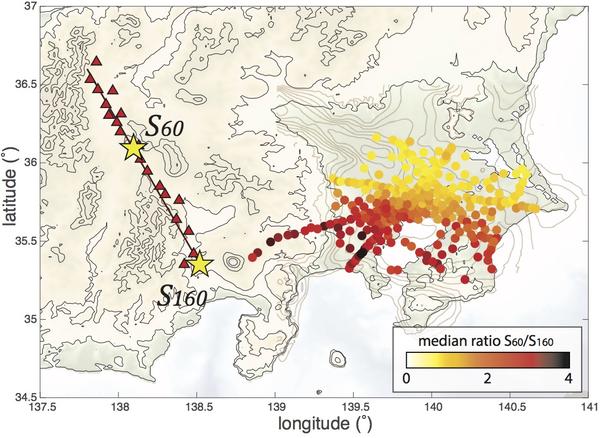
Coupling of path and source directivity for M7.6 scenario earthquakes on the Itoigawa-Shizuoka Tectonic Line and predicted at the 296 MeSO-net seismic stations (Denolle et al., in prep).
Our areas of foci are the greater Los Angeles, Seattle, Tokyo, Jakarta.